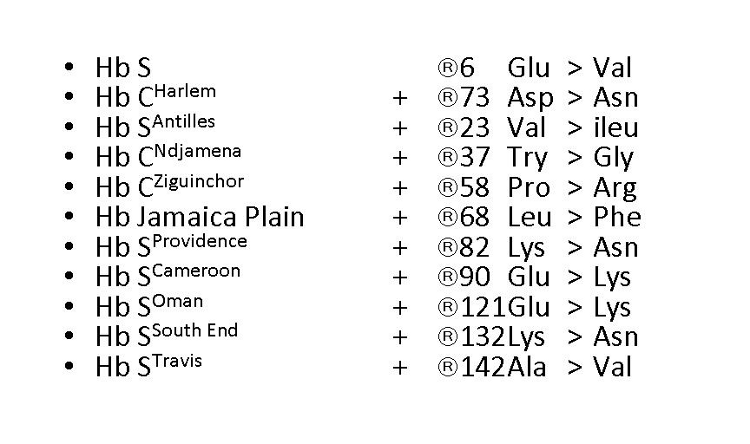Aetiology
Sickling occurs when red blood cells containing sickle haemoglobin become rigid and distorted into a crescent shape. In sickle cell anaemia, valine replaces glutamic acid at the sixth amino acid of the beta globin chain, as a result of a recessive single gene mutation.[8] Valine can fit into the hydrophobic pocket of another haemoglobin molecule, causing the haemoglobin to polymerise within the red cell, thus forming long stiff fibres of haemoglobin tetramers.
Sickle cell trait occurs when a child inherits a sickle gene from one parent and a normal gene from the other parent. Sickle cell disease occurs when a child inherits a sickle gene from each parent.[8]
Sickle beta-thalassaemia occurs when a child inherits a sickle gene from one parent and a beta-thalassaemia gene from the other parent. In patients with sickle beta-thalassaemia, a mutation of the beta gene blocks production of the normal beta globin chain (beta 0) or reduces its production (beta +).[9]
Haemoglobin SC disease occurs when a child inherits a sickle gene from one parent and haemoglobin C mutation from the other parent. The haemoglobin C mutation is an amino acid substitution of lysine for glutamic acid at the 6th position of the beta globin chain. Those with haemoglobin SC disease make no haemoglobin A.[9][Figure caption and citation for the preceding image starts]: The sickling haemoglobins and the mutations that cause themFrom the collection of Dr Adrian Stephens, University College London Hospitals, London, UK; used with permission [Citation ends].
Pathophysiology
Polymerisation of sickle haemoglobin in red blood cells can be triggered by hypoxia and acidosis, which causes cells to become rigid and deform into a sickle (crescent) shape. These deformed cells may cause vaso-occlusion in the small vessels or adhere to vascular endothelium, resulting in intimal hyperplasia in larger vessels and slowing blood flow.[10] These deformed cells are also prone to haemolysis, which contributes to anaemia.
Sickle cell disease is considered an inflammatory state with abnormal activation of monocytes and granulocytes.[11] Precipitating factors for vaso-occlusive episodes are not fully understood, but known precipitants include acidosis, dehydration, cold temperatures, extreme exercise, stress, and infections.[12]
When anaemia is severe, high blood flow may result in cardiomegaly. Splenic sequestration or temporary bone marrow aplasia can cause circulatory failure and become life-threatening in children. From an early age, splenic dysfunction increases vulnerability to serious infections.
Long-standing intravascular haemolytic anaemia results in a relative deficiency of nitrous oxide (NO), caused by release of haemoglobin and arginase from lysed red blood cells that scavenge NO. Nitrous oxide deficiency can cause thrombosis as well as pulmonary vasoconstriction and endothelial dysfunction, which can lead to pulmonary hypertension.[13]
Clinical features of sickle cell disease vary greatly from patient to patient. Many of the reasons for this variation are not clear; it is known that persistently elevated levels of fetal haemoglobin (HbF) and co-inheritance of alpha thalassaemia can minimise the clinical severity of the disease. Some people may remain totally asymptomatic into late childhood or are only incidentally diagnosed.
Sickle cell trait is associated with increased risk of pulmonary embolism, exertional rhabdomyolysis, chronic kidney disease, haematuria, proteinuria and end stage renal failure.[14]
Classification
US newborn screening system guidelines II: follow-up of children, diagnosis, management, and evaluation. Statement of the Council of Regional Networks for Genetic Services (CORN)[1]
From NIH, Division of Blood Diseases and Resources:
Sickle cell disease-SS: 65% of US patients; genotype HbSS
Sickle cell disease-SC: 25% of US patients; genotype HbSC
Sickle cell disease-S beta + thalassaemia: 8% of US patients; genotype HbSB+ thalassaemia
Sickle cell disease-S beta 0 thalassaemia: 2% of US patients; genotype HbSB0 thalassaemia.
Use of this content is subject to our disclaimer